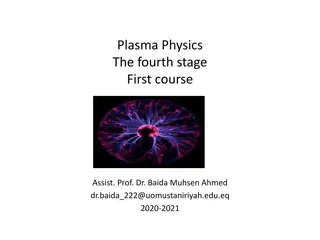Research Program on Spin Polarized Nuclei in Fusion Plasmas
Examination of spin polarized fuel in fusion plasmas to enhance energy production efficiency. Planned experiments aim to measure the lifetime of polarized nuclei for optimized fusion reactions. Key aspects include depolarization mechanisms, neutral beam heating, and fueling techniques with pellets.
5 views • 36 slides
Gases and Plasmas in the Atmosphere
Delve into the concepts of gases and plasmas in the atmosphere, exploring topics such as fluid pressure, buoyancy, and the unique properties of gases compared to liquids. Discover how the balance between kinetic energy and gravity determines the thickness of our atmosphere and why it is essential fo
1 views • 25 slides
Linearly Transformed Discretization Schemes for Plasma Simulations
Addressing the computational challenge of CO2 decomposition with plasmas, this study focuses on developing advanced discretization schemes and modern iterative linear solvers to ensure physical invariants are respected. The research explores the use of chemical invariants to simplify complex systems
3 views • 22 slides
Runaway Electrons in Tokamak Disruptions: Current Status and Future Directions
The article discusses the current knowledge and open questions regarding runaway electrons in tokamak disruptions, focusing on prospects for ITER tools and plans. It covers theoretical frameworks, RE generation mechanisms, validation models, and challenges in disruption scenarios. The need for self-
1 views • 20 slides
Advanced Beam Diagnostics and Control Systems in Beam Physics
Cutting-edge detector technologies like KAPTURE and KALYPSO are revolutionizing beam diagnostics with ultra-fast Terahertz detectors and advanced line-camera systems. The POF III and POF IV projects focus on extreme beam control and diagnostics, aiming to probe femto-scale dynamics of relativistic p
3 views • 8 slides
Hydrogen Isotope Influence on H-Mode Confinement in Fusion Plasmas
Knowledge of how the hydrogen isotope impacts H-mode confinement is crucial for predicting energy confinement in future fusion plasmas. Research explores the relationship between isotope mass and confinement time, highlighting the optimistic outlook for future reactors. Experimental studies on hydro
0 views • 13 slides
Study on Energetic Particle Transport and Loss in Magnetic Confinement Systems
Investigation into energetic particle transport and loss induced by helically-trapped energetic-ion-driven resistive interchange modes in the Large Helical Device (LHD) for sustaining high-temperature and high-density plasmas. Utilizing neutron diagnostics and comprehensive neutron monitors, this st
0 views • 21 slides
X-ray Spectroscopy of Coronal Plasmas in the Solar Corona
Explore the physical properties and ionization conditions of coronal plasmas as revealed through X-ray spectroscopy in the solar corona. Discover how high temperatures and ionization stages impact the equilibrium of elements like Fe, shedding light on the complex nature of these ionized gases. Unvei
2 views • 23 slides
Fascinating World of Gases and Plasmas in Chapter 14
Delve into the intriguing realm of gases and plasmas as we transition from liquids in Chapter 13. Understand the dynamics of fluid pressure, buoyancy, and the unique characteristics that differentiate gases from liquids. Explore examples illustrating the concepts and ponder over the mysteries of our
4 views • 28 slides
Plasma Physics: The Fourth Stage First Course by Prof. Dr. Baida Muhsen Ahmed
Plasma, the fourth state of matter, was introduced by Langmuir in 1928. It is a unique form of matter containing ions and exhibits collective behavior. This course explores the relationship between solid, liquid, gas, and plasma, discussing forces, parameters, and where plasmas are found in the cosm
4 views • 11 slides
Recent Developments in Plasma Reconnection Experiments
Explore key open issues in plasma reconnection such as trigger/onset problems, turbulence effects, 3D reconnection, and the impact on heating and acceleration. Discover new experimental developments like the Big Red Ball at Wisconsin for field-free plasma confinement and access to different reconnec
2 views • 8 slides
Development of NS-GEM Neutron Spectrometer for Fusion Plasmas
This project focuses on developing a compact neutron spectrometer, NS-GEM, using gas electron multiplier detector technology for fusion plasma applications. The goal is to achieve high energy resolution, low sensitivity to γ-rays, and high count rate capabilities for accurate neutron measurements.
0 views • 22 slides
Development of EIRENE-NGM for Neutral Gas Dynamics in Fusion Reactors
EIRENE-NGM project focuses on enhancing the neutral gas dynamics model for fusion reactor simulations, including efficient HPC utilization, physics basis refinement, database improvement, interface development, and predictive capability validation. Collaborators from various institutes aim to create
0 views • 17 slides
Electromagnetic Waves in a Plasma Study
the dynamics of electromagnetic waves in plasma environments, including simple models for dielectrics, conductors, and plasmas. Discussing equations of motion for bound electrons, Lorentz dielectric model, and topics like effective permittivity, plasma frequency, and susceptibility.
2 views • 27 slides
Plasma Antenna Technology at College of Engineering, Perumon
The world of plasma antenna technology and its applications at College of Engineering, Perumon. Discover the unique characteristics, working principles, and various types of plasmas used in different scenarios. From artificially produced plasmas to astrophysical plasmas, delve into the fascinating r
2 views • 23 slides
Kick-off meeting SP X1
In-depth exploration of atomic and molecular processes in attached/detached plasmas, focusing on ro-vibrational states of H2 and isotopes. The goal is to determine distribution and densities, crucial for SOL modeling and power flux mitigation. Includes discussions on measurement techniques, reaction
2 views • 6 slides
TSVV Task 5: Neutral Gas Dynamics in the Edge
EIRENE-NGM is a crucial tool for modeling neutral gas dynamics in fusion plasma research. This collaboration aims to enhance the EIRENE code for efficient simulations on large plasma scales, focusing on detached divertor plasmas. The project involves developing advanced physics models and improving
1 views • 16 slides
Plasma Conditions in JET Unseeded L-Mode Plasmas
Explore the scrape-off layer regimes and plasma conditions in JET unseeded L-mode plasmas as discussed during the EIRENE-Yacora meeting. Find out how attached and detached plasma conditions were achieved in the outer divertor, along with methods of measuring plasma parameters like electron temperatu
2 views • 6 slides
Maxwell's Equations and Electromagnetic Phenomena
Learn about Maxwell's equations, Lorentz force, constitutive relations, boundary conditions, and conservation laws governing electromagnetic fields. Explore how charges and currents impact energy and flux in various materials. Dive into the fundamental principles of dielectrics, conductors, and plas
4 views • 47 slides
Studies on Core Particle Transport: Evolution and Implications
Explore the evolution of core particle transport during L-H transitions in fusion plasmas, impacting key parameters like radiated power and particle loss. Understand the importance of the evolution of core Te and ne, which can determine the plasma's fate between burning sustainably or reverting to L
3 views • 5 slides
Efficient Atomic Process Modeling with Coupled-Channel Approximation
Explore the efficient use of the coupled-channel approximation and R-Matrix method in solving electron-ion interactions, from computing ion wavefunctions to diagonalization of the Hamiltonian for various atomic processes in plasmas. Dive into the stages and flow chart of R-Matrix codes, as well as t
5 views • 5 slides
Atomic and Molecular Processes in Plasma and Sheath Effects
Explore atomic and molecular processes in attached/detached plasmas with a focus on the distribution of ro-vibrationally excited states of hydrogen and its isotopes. The kick-off meeting addresses the status, synchronization of work, and possible delays in achieving the ultimate goal of determining
0 views • 6 slides
Understanding Electron Thermal Transport in ST Plasmas
Explore the validation and development of reduced transport models for electron thermal transport in spherical torus plasmas. The research aims to enhance the accuracy of fluid-based models by comparing them with gyrokinetic simulations and experimental data, ultimately determining the physics regim
1 views • 21 slides
Advanced Meeting Agenda Updates
Stay up-to-date with the latest advancements and tasks in the multi-species plasmas project. Get insights on the 2023 work plan, end-of-year report preparation, and upcoming numerical workshop. Check out today's meeting agenda and important updates from Patrick Tamain.
1 views • 6 slides
Detailed TOMAS Wall Conditioning Plasma Optimization
Explore the characterization and optimization of TOMAS wall conditioning plasmas, including investigating effectiveness of cleaning methods, studying energetic neutrals, and analyzing impurity removal. Tasks involve diagnostic upgrades, plasma modeling, material cleaning, and coordinating experiment
1 views • 4 slides
Analytical Approach to Determining Distribution Functions
Explore the analytical approach to determining distribution functions for collisionless current sheet equilibria in solar system plasmas. The study involves calculating current density, solving Ampère's Law, and addressing the inverse problem to find a self-consistent solution. Through methods like
1 views • 12 slides

























